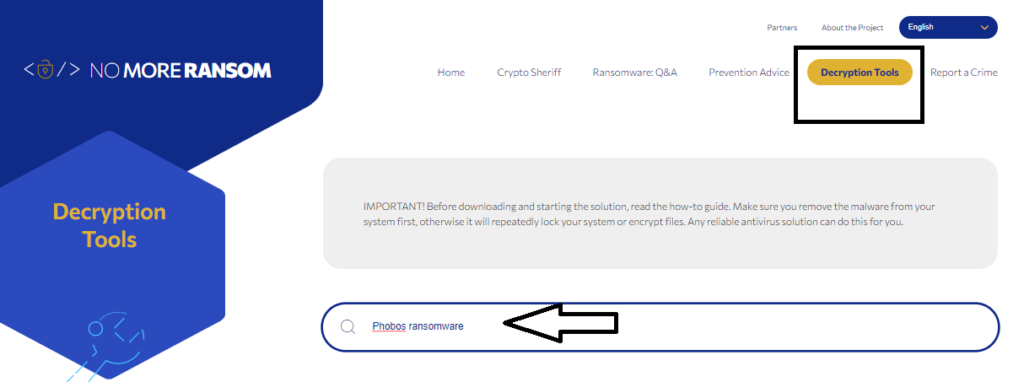Remove Tywd Ransomware And Recover Locked Files
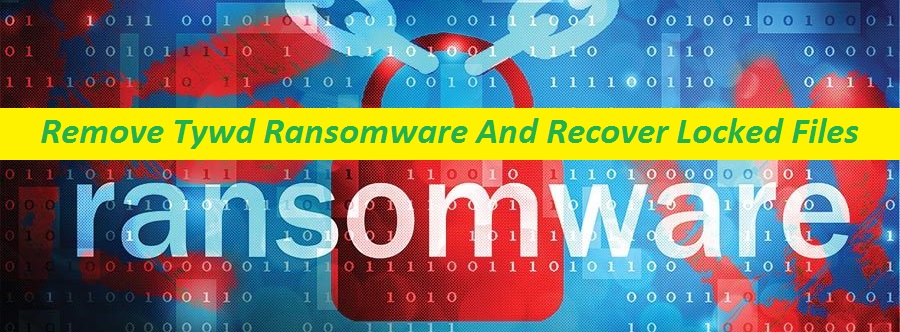
Removing Tywd Ransomware involves isolating the infected system, terminating the malware procedure, and eliminating the virus. For safe and successful removal, it is crucial to take professional assistance. The guide given below provides step-by-step Tywd virus removal instructions.
Simple Process To Uninstall Crypto-Malware
Depth View On Tywd Ransomware:
Tywd Ransomware is a type of dangerous malware that encrypted files on the computer systems and then demands a ransom payment from the victims for their release. It’s a highly destructive threat that can cause significant damage to both individuals and businesses. Tywd virus is a new variant of STOP/DJVU ransomware and mainly targets Windows-based devices. Like ALC Ransomware, and other similar infections, it can encrypt nearly all types of files, making them inaccessible. It in general employs a sophisticated encryption algorithm, making it very difficult to unlock the data without the decryption key.
Threat Details
Name: Tywd Ransomware
Class: Ransomware, Crypto-virus, File-locking malware
Features: Tends to encrypt users’ files and ask them to pay ransom money for the decryption
Extension: .tywd
Ransom note: _readme.txt
Danger level: High
Ransom Amount: $490/$980
Attackers’ Contact: [email protected], [email protected]
Symptoms: Data cannot be accessed, strange file extension, display of ransom note
Distribution: Malicious email attachments, infected websites
How does Tywd Ransomware work?
Tywd Ransomware typically spreads through phishing emails, malicious links, or unsafe web places. Once the malware infects a PC, it begins encrypting files and also appends the “.tywd” extension to each infected file. After completing the encryption process, this virus displays a ransom note named “_readme.txt” demanding payment for the decryption key. The hackers usually request payment in cryptocurrency, such as Bitcoin, to make it difficult to track the funds. The ransom amount of $980 but if victims contact the attackers via [email protected] or [email protected] email address within 72 hours, the sum will be halved.
Is It Good To Pay The Attackers?
It is not recommended that Tywd Ransomware victims pay the ransom to the attackers. Paying doesn’t guarantee that the crooks will provide you the decryption key or that the data will be restored. In addition to that, meeting these hackers’ demands only encourages them to continue their criminal activities and may fund further attacks. Instead, the affected individuals should report the attack to the law enforcement and seek professional assistance to remove Tywd Ransomware and recover the files.
How To Recover The Infected Files?
Recovering files locked by ransomware can be a challenging process, but there are several options available to victims. The first step is to isolate the infected device and remove the malware. If the victim has a backup of their data, they can restore their files from the backup. If there is no backup, there are decryption tools available for some types of ransomware that can help recover encrypted files. However, not all ransomware can be decrypted, and in some cases, victims may need to seek the assistance of cybersecurity professionals. The file-recovery software provided below may help get your files back. You can employ it once you terminate the nasty infection.
Frequently Asked Questions
How can I open files locked by Tywd Ransomware?
These files cannot be opened directly regardless of what you try. If you want to get them back, you need to recover them using backup copies, free online decryptor, third-party file-recovery software, or via other option. Before going for any recovery method, virus removal is a must.
Should I pay to the attackers?
No matter what the situation is, you should never pay even a single bit of ransom to the attackers. That’s because these people cannot be trusted, and they may just fade away after receiving the money. Instead, remove the parasite from the system and then try to retrieve the data via alternatives.
Message In The Ransom Note:
ATTENTION!
Don’t worry, you can return all your files!
All your files like pictures, databases, documents and other important are encrypted with strongest encryption and unique key.
The only method of recovering files is to purchase decrypt tool and unique key for you.
This software will decrypt all your encrypted files.
What guarantees you have?
You can send one of your encrypted file from your PC and we decrypt it for free.
But we can decrypt only 1 file for free. File must not contain valuable information.
You can get and look video overview decrypt tool:
hxxps://we.tl/t-f8UEvx4T0A
Price of private key and decrypt software is $980.
Discount 50% available if you contact us first 72 hours, that’s price for you is $490.
Please note that you’ll never restore your data without payment.
Check your e-mail “Spam” or “Junk” folder if you don’t get answer more than 6 hours.
To get this software you need write on our e-mail:
Reserve e-mail address to contact us:
Your personal ID:
–
Step1. Remove Connected Devices and Isolate the Infected PC
It is very important that you cut off your infected PC with other computers connected in the same local network. Many of the ransomware are designed in such a way that it spreads in network environment. Hence, you need to take some measures to isolate the PC.
There are two basics steps for separate the infected device.
- Disconnect Internet
- Unplug all the external storage device
- Log out of Cloud Storage Accounts (Additional)
Unplug the Ethernet Cable so that all the wired internet connection gets cut off. In case if the infected PC is connected with wireless internet, you have to disconnect it manually through Control Panel.
Go to Control Panel> Search ‘Network and Sharing Center’

Click on ‘Change adapter settings’

Select the internet connect point, right lick on it and choose ‘Disable’. The PC is no longer connected with internet.

Once the PC is disconnected with internet, the next step is to unplug the connected storage device in order to isolate the computer completely. All kind of storage device such as portable hard drives, pen-drives, flash drives etc. is to be removed so that Tywd Ransomware doesn’t encrypts files stored in them.
Go to “My Computer”, right click on the connected storage device and select “Eject”.

There is high possibility that ransomware could take over the software that handles data stored in “cloud storage”. Hence it is strongly recommended that you log out from your cloud storage whether it is through browser or cloud management software.
Step2. Identify the Ransomware that Attacked your Files
It is important to identify the name and type of ransomware that had attacked your work-station so that you can use the right decryption tool for recovering the locked files. This is important because decryption tool for ransowmare released by security experts are exclusive for particular ransomware and their family. If you use incorrect decryption tool which is not designed for removing Tywd Ransomware, then this may damage the locked files permanently.
There are possibly three ways to identity the ranosmware infected your PC. First is to go through the rnasowmare note and see if the name is mentioned or not. For example, In Cerber ransomware note, the name of ransomware is clearly mentioned.

On many occasion, the ransomware name is not mentioned in the note. They contain generic message. Researches shows that different rasnowmare may have same ransom note but they belong from entirely different family or group.
So, if the ransomware note is generic and its name and type is not mentioned, you need to check file extension that it adds on the locked file. When a ransomware locks any file, it appends its own extension name to it in addition. For example, Locky ransomware adds .locky extension name on every files that it encrypts.

Many of the ransomware uses generic extension names as well such as .encrypted, .locked, .crypted etc. In this case, the generic extension name doesn’t reveals anything about the ransomware name and type.
So, if you are unable to identify the ransomware through its note and extension, it is best to visit ID Ransomware website and upload the ransom note you receive or any one of your file that has been encrypted or possibly both.
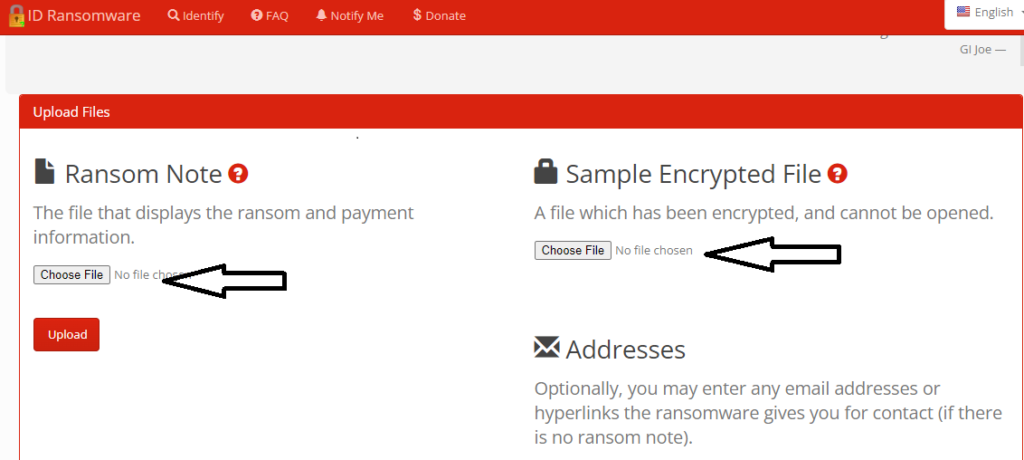
At present, ID ransowmare database has details of around 1100 different ransomwares. In case if the ransomware that infected your files is not supported by ID ransomware website, you can use internet to search more about the ransomware using keywords like its file extension, crypto wallet address or contact email Id.
Step 3. Search for Tywd Ransomware Decryption Tool to Recover Locked Files
The developer behind ransomware uses highly advanced encryption key to lock the files on the infected PC and hence if it manages to encrypt the file properly, it cannot be decrypted without the correct decryption key. The unlock key is stored in a remote server. Popular ransowmare family such as Dharma, Cerber, Phobos etc. are known to create flawless ransomware and they update their version time to time.
However, there are so many ransomware types that are poorly developed and have flaws in terms of using unique decryption key for each victim, their decryption key are stored on the infected PC instead of remote server and so on. So, the decryption key for such poorly designed ransomware are available on internet. You just have to check some security forums and Online communities to get identical decryption key for poorly designed ransowmare.
To be on safer side, it is recommended to use platforms such as https://www.nomoreransom.org/en/index.html which have tried and tested decryption key for some of the popular ransomware. Its homepage contains a “Decryption Tools” category with search bar option where you can search for decryption key for a particular ransomware.
How to Remove Tywd Ransomware and Recover locked Files Using Data Recovery Tool
1: Boot the PC “Safe Mode with Networking”
For Windows XP and Windows 7 users: Boot the PC in “Safe Mode”. Click on “Start” option and continuously press on F8 during the start process until the “Windows Advanced Option” menu appears on the screen. Choose “Safe Mode with Networking” from the list.

Now, a windows home screen appears on the desktop and work-station is now working on “Safe mode with networking”.
For Windows 8 Users: Go to the “Start Screen”. In the search results select settings, type “Advanced”. In the “General PC Settings” option, choose “Advanced startup” option. Again, click on the “Restart Now” option. The work-station boots to “Advanced Startup Option Menu”. Press on “Troubleshoot” and then “Advanced options” button. In the “Advanced Option Screen”, press on “Startup Settings”. Again, click on “Restart” button. The work-station will now restart in to the “Startup Setting” screen. Next is to press F5 to boot in Safe Mode in Networking.

For Windows 10 Users: Press on Windows logo and on the “Power” icon. In the newly opened menu, choose “Restart” while continuously holding “Shift” button on the keyboard. In the new open “Choose an option” window, click on “Troubleshoot” and then on the “Advanced Options”. Select “Startup Settings” and press on “Restart”. In the next window, click on “F5” button on the key-board.

Once the PC get booted in Safe mode with networking, you can use anti-malware tool such as “SpyHunter”. The automatic removal tool has advanced scanning algorithm and programming logics hence it doesn’t leave any trace of ransomware behind.
Click Here For SpyHunter Details and User Guide
Open the browser and download a legitimate anti-malware tool. Do a full System scanning. Remove all the malicious detected entries including those belong to ransomware.
Special Offer (For Windows)
Tywd Ransomware can be creepy computer infection that may regain its presence again and again as it keeps its files hidden on computers. To accomplish a hassle free removal of this malware, we suggest you take a try with a powerful Spyhunter antimalware scanner to check if the program can help you getting rid of this virus.
Do make sure to read SpyHunter’s EULA, Threat Assessment Criteria, and Privacy Policy. Spyhunter free scanner downloaded just scans and detect present threats from computers and can remove them as well once, however it requires you to wiat for next 48 hours. If you intend to remove detected therats instantly, then you will have to buy its licenses version that will activate the software fully.
Data Recovery Offer
We Suggest you to choose your lately created backup files in order to restore your encrypted files, however in case if you don’t have any such backups, you can try a data recovery tool to check if you can restore your lost data.
2: Delete Tywd Ransomware Infection using “System Restore”
In case if you cannot start the PC in “Safe Mode with Networking”, Try using “System Restore”. During the “Startup”, continuously press on F8 key until the “Advanced Option” menu appears. From the list, choose “Safe Mode with Command Prompt” and then press “Enter”

In the new opened command prompt, enter “cd restore” and then press “Enter”.

Type: rstrui.exe and Press “ENTER”

Click “Next” on the new windows

Choose any of the “Restore Points” and click on “Next”. (This step will restore the work-station to its earlier time and date prior to Tywd Ransomware infiltration in the PC.

In the newly opened windows, press on “Yes”.

Once your PC gets restored to its previous date and time, download the recommended anti-malware tool and perform a deep scanning in order to remove Tywd Ransomware files if they left in the work-station.
In order to restore the each (separate) file by this ransomware, use “Windows Previous Version” feature. This method is effective when “System Restore Function” is enabled in the work-station.
Important Note: Some variants of Tywd Ransomware delete the “Shadow Volume Copies” as well hence this feature may not work all the time and is applicable for selective computers only.
How to Restore Individual Encrypted File:
In order to restore a single file, right click on it and go to “Properties”. Select “Previous Version” tab. Select a “Restore Point” and click on “Restore” option.

In order to access the files encrypted by Tywd Ransomware, you can also try using “Shadow Explorer”. In order to get more information on this application, press here.

Important: Data Encryption Ransomware are highly dangerous and it is always better that you take precautions to avoid its attack on your work-station. It is advised to use a powerful anti-malware tool in order to get protection in real-time. With this help of “SpyHunter”, “group policy objects” are implanted in the registries in order to block harmful infections like Tywd Ransomware.
Also, In Windows 10, you get a very unique feature called “Fall Creators Update” that offer “Controlled Folder Access” feature in order to block any kind of encryption to the files. With the help of this feature, any files stored in the locations such as “Documents”, “Pictures”, “Music”, “Videos”, “Favorites” and “Desktop” folders are safe by default.

It is very important that you install this “Windows 10 Fall Creators Update” in your PC to protect your important files and data from ransomware encryption. The more information on how to get this update and add an additional protection form rnasomware attack has been discussed here.
3. How to Recover the Files Encrypted by Tywd Ransomware?
Till now, you would have understood that what had happed to your personal files that got encrypted and how you can remove the scripts and payloads associated with Tywd Ransomware in order to protect your personal files that has not been damaged or encrypted until now. In order to retrieve the locked files, the depth information related to “System Restore” and “Shadow Volume Copies” has already been discussed earlier. However, in case if you are still unable to access the encrypted files then you can try using a data recovery tool.
Use of Data Recovery Tool
This step is for all those victims who have already tries all the above mentioned process but didn’t find any solution. Also it is important that you are able to access the PC and can install any software. The data recovery tool works on the basis of System scanning and recovery algorithm. It searches the System partitions in order to locate the original files which were deleted, corrupted or damaged by the malware. Remember that you must not re-install the Windows OS otherwise the “previous” copies will get deleted permanently. You have to clean the work-station at first and remove Tywd Ransomware infection. Leave the locked files as it is and follow the steps mentioned below.
Step1: Download the software in the work-station by clicking on the “Download” button below.
Step2: Execute the installer by clicking on downloaded files.

Step3: A license agreement page appears on the screen. Click on “Accept” to agree with its terms and use. Follow the on-screen instruction as mentioned and click on “Finish” button.

Step4: Once the installation gets completed, the program gets executed automatically. In the newly opened interface, select the file types that you want to recover and click on “Next”.
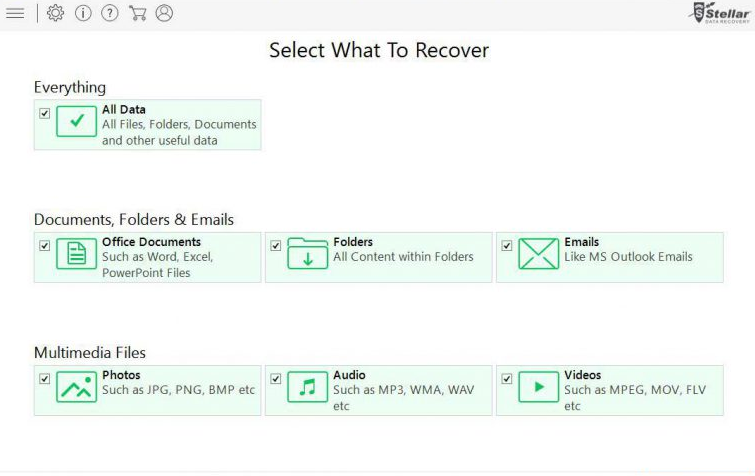
Step5: You can select the “Drives” on which you want the software to run and execute the recovery process. Next is to click on the “Scan” button.

Step6: Based on drive you select for scanning, the restore process begins. The whole process may take time depending on the volume of the selected drive and number of files. Once the process gets completed, a data explorer appears on the screen with preview of that data that is to be recovered. Select the files that you want to restore.

Step7. Next is to locate the location where you want to saver the recovered files.
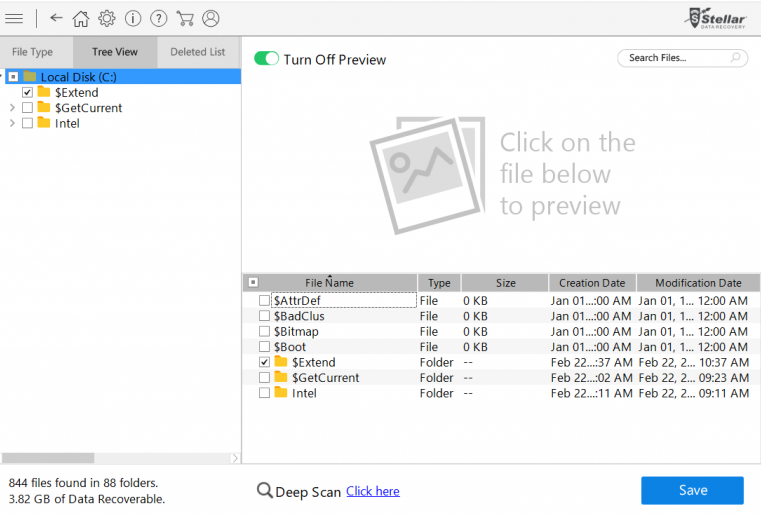
Special Offer (For Windows)
Tywd Ransomware can be creepy computer infection that may regain its presence again and again as it keeps its files hidden on computers. To accomplish a hassle free removal of this malware, we suggest you take a try with a powerful Spyhunter antimalware scanner to check if the program can help you getting rid of this virus.
Do make sure to read SpyHunter’s EULA, Threat Assessment Criteria, and Privacy Policy. Spyhunter free scanner downloaded just scans and detect present threats from computers and can remove them as well once, however it requires you to wiat for next 48 hours. If you intend to remove detected therats instantly, then you will have to buy its licenses version that will activate the software fully.
Data Recovery Offer
We Suggest you to choose your lately created backup files in order to restore your encrypted files, however in case if you don’t have any such backups, you can try a data recovery tool to check if you can restore your lost data.
Some Related FAQs
How can I open files encrypted by Tywd Ransomware? Can I access it myself?
A file that is locked by ransomware cannot be accessed unless it is first decrypted using the decryption key.
What could I do to access the locked files?
In case if you have backup files, use it and don’t worry about the files that got encrypted since you can use it from backup. However remember that in order to use the backup files on same PC, you first have to remove the ransomware infection completely otherwise the backup file will get encrypted as well. For removing the ransommare, it is suggested to use a powerful anti-malware tool.
In case if the backup is not available, you can try “Restore Point” to roll back the System to point where the PC was free from ransomware attack. If these options doesn’t works then you can try your luck with any powerful data recovery tool.
Additionally, there is high possibility that the encrypted files are still with you hence you can check all the possible locations such as sent or received emails, contact your friends, family members to get files like images, videos, etc. that would have shared earlier. Check your cloud storage and social media platforms, old devices including laptop, PC, mobile phones and so on.
Should I Pay Ransom in order to get decryption key?
It is never recommended to pay money because there is no guarantee of receiving the correct decryption key from cyber-criminals even after the ransom amount is paid. The identity of cyber-criminals are often key anonymous hence you cannot do anything much later.
Where can I report about the ransowmare attack?
There are cyber-security agencies in every country where you can report about ransomware attack. The links for the respective authorities are as follow. You can visit the link as per your country and report about the attack.
- USA– Internet Crime Complaint Centre IC3 or On Guard Online;
- In Canada- Canadian Anti-Fraud Centre;
- United Kingdom– Action Fraud
- Australia – Australian High Tech Crime Center
- In Ireland- An Garda Síochána
- Greece – Cyber Crime Unit (Hellenic Police)
- New Zealand- Consumer Affairs Scams
- Spain– Policía Nacional
- Poland– Policja
- Portugal– Polícia Judiciária
- France– Ministère de l’Intérieur
- Germany– Polizei
- Italy– Polizia di Stato
- The Netherlands– Politie
- India – CyberCrime Investigation Cell
Can Antivirus protect against ransomware?
A powerful antivirus can protect, detect as well as remove ransomware. It is always a good practice to use a security application in order to get protection from ransomware in real-time. Additionally, it is equally important to follow good cyber-security practices.

